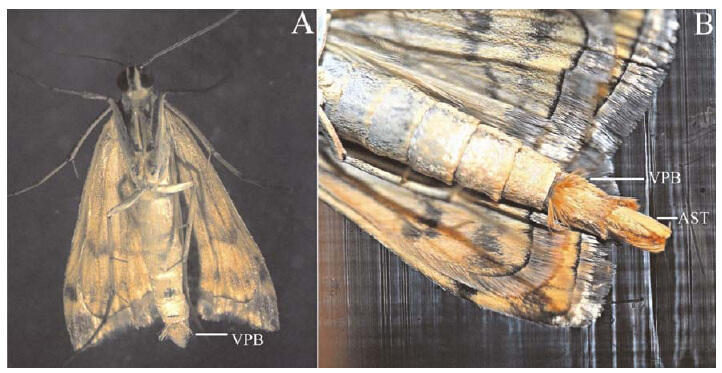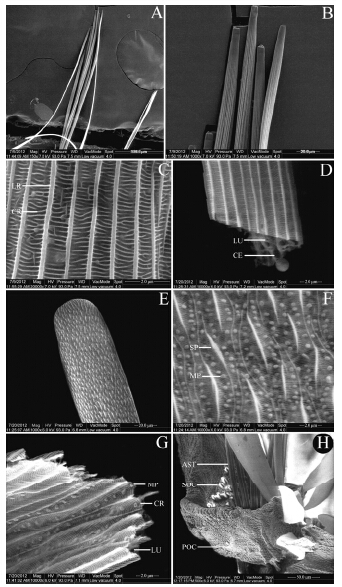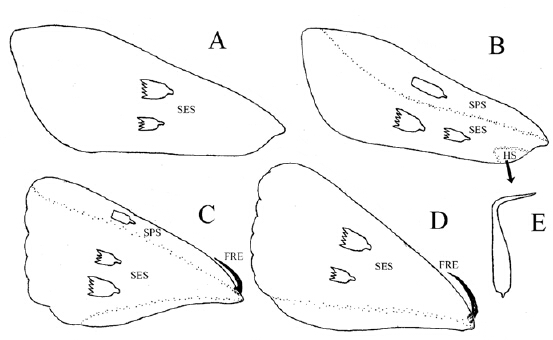扩展功能
文章信息
- 刘科科, 肖永红, 程云霞, 罗礼智
- LIU Keke, XIAO Yonghong, CHENG Yunxia, LUO Lizhi
- 草地螟成虫体表鳞片的类型、位置和超微形态结构特征
- The Category, Location and Ultrastructure of Scales of Adult Loxostege sticticalis L.(Lepidoptera: Pyralidae)
- 四川动物, 2015, 34(4): 524-533
- Sichuan Journal of Zoology, 2015, 34(4): 524-533
- 10.11984/j.issn.1000-7083.2015.04.008
-
文章历史
- 收稿日期:2014-11-05
- 接受日期:2015-02-04
2. 井冈山大学生命科学学院, 江西吉安 343009
2. College of Life Sciences, Jinggangshan University, Ji'an, Jiangxi Province 343009, China
鳞片是鳞翅目Lepidoptera昆虫体表普遍存在的结构,其颜色、形态和功能各异。它是由表皮细胞的子细胞发育形成(Nijhout,1985;Yoshida & Aoki,1989),同时也分化出包裹鳞片基部的毛囊。鳞片颜色是一种生物色,是由表面的脊、纹、小面(片)、颗粒等微观结构对光线的干涉、散射、衍射等作用(Vukusic et al.,1999),或由虫体所含色素吸收特定波长的光而产生的变化(邵起生,1995),或由前两种方式形成混合色(关会英,2007),如蝴蝶和蛾类的红色、绿色、蓝色、黑色等颜色,其在仿生学中应用较多(Watanabe et al.,2005;Biró et al.,2008;Tanaka et al.,2008)。Downey和Allyn(1975)按形态结构将鳞片分为3类:毛型鳞(横截面为圆形或椭圆形)、薄片鳞(横截面为卵圆形、倒卵圆形或披针形)和其他形状。按排列方式,鳞片可分为基鳞和覆鳞(Yoshida & Aoki,1989;Kumazawa et al.,1996)。鳞片有许多特殊的功能,可用来保护(伪装、警戒或拟态等)、绝缘(保温、防尘)、交流(化学通讯、传播气味、吸引异性等)、增强飞行能力等(Scoble,1992;Kristensen & Simonsen,2003),以此适应各种复杂的环境。
草地螟Loxostege sticticalis L.属鳞翅目螟蛾科Pyralidae,是一种世界性害虫(Pepper,1938;Knor et al.,1993;Frolov et al.,2008),曾给我国农牧业生产造成过巨大的经济损失(罗礼智,2004;罗礼智等,2009)。幼虫淡灰绿或黄绿色。成虫灰褐色,体长8~10 mm(张希林,1999),前翅中央近前缘有1个黄白色的斑纹,这种体色通常与其栖息场所非常近似而形成保护色;成虫能够远距离迁飞,最远距离可达1200 km(陈阳等,2012);另外,羽化后的雄蛾,3日龄后,抱握器背侧的腹后鳞簇会间断性的外翻(刘科科等,2013),且处在第8腹节的腹后毛刷也会有规律地打开(Xiao et al.,unpublished),这是雄蛾求偶的一种特殊方式。这些特征或行为都与体表鳞片有着紧密的关系,所以同为表皮细胞分化而来的体表鳞片,有哪些特殊结构或功能呢?因此,本文借助光学显微镜、扫描电子显微镜等仪器对草地螟成虫体表鳞片的超微形态结构进行了观察,并探讨了它们与生理机能的关系,为草地螟的形态学、行为学和进化研究方面提供一些理论依据。刘科科等:草地螟成虫体表鳞片的类型、位置和超微形态结构特征 1 材料与方法 1.1 虫源采集和培育
2011年7月自河北省康保县(41.87°N,114.6°E)采集草地螟蛹,经实验室培养繁育作为试验用虫。幼虫均以20头饲养在650 mL的罐头瓶中,喂以新鲜灰藜Chenopodium album (L.),幼虫老熟后将其转入含水量约10%和厚为5~10 cm的沙土中待其化蛹。一部分羽化后的成虫以12头饲养在2 L的塑料罩内(雌雄分开);另一部分挑选出雌性、雄性成虫单独饲养在245 mL(5 cm×12.5 cm)的有机玻璃罩中。罩子顶部用脱脂棉浸润10%的葡萄糖水作为成虫食物。卵、幼虫、蛹和成虫整个阶段的饲养条件为温度(21±1)℃,湿度70%~75%,光周期为L16:D8。 1.2 鳞片的光镜和电镜样品制备
将羽化后的雌、雄蛾放入充满乙醚的指形管中,待其晕厥1 min左右取出成虫,拨开前翅,沿前翅基部前端和后翅基部分别剪下放入干净的培养皿中,在光学显微镜Leica(MZ75,DFC420)、Zeiss(Discovery V12,Scope A1)下拍照。用解剖针剖离后翅内缘约4 mm2的翅膜,并取其附近3~5根长鳞片,另截取前翅基部小片,分别放入装有70%酒精的10 mL离心管中。将雄蛾从第8腹节截断,于光镜下拍照,然后用镊子去除抱握器基部的鳞片并挑出基部长鳞片置于70%的酒精中。另取几头雄蛾,分别截下第7~8腹节,并用镊子挑出第8腹节长鳞片数根,放入70%酒精中。所有贮存在70%酒精中的鳞片和腹节用作电镜观察的样品。鳞片结构测量在显微镜和电镜自带软件中完成。 1.3 超微结构观察
将贮存在70%酒精中的鳞片和腹节样品经过80%、90%、100%酒精浓度梯度脱水,每个浓度脱水10 min,通过干燥(Leica EM CPD030)、喷金(Eiko IB-5 Ion Cater)在环境扫描电镜下(FEI ComponyQuahta 200 FEG)观察各鳞片结构并拍照。 1.4 求偶和交尾行为观察
在暗期中,用红外光分别观察1~8日龄及配对后雄蛾的性行为,持续观察雄性求偶和交尾行为中鳞片的变化。当雄蛾表现出求偶行为时,对其腹后毛刷、腹后鳞簇进行拍照,并记录雌雄蛾行为变化。 2 结果 2.1 草地螟成虫体表鳞片类型和分布
草地螟雌雄成虫(雄成虫体表鳞片包括了雌性成虫体表鳞片种类,以雄性为例,图版1)体表覆盖的鳞片有2种:薄片型(lamellar scale)和长毛型(piliform scale)。薄片型鳞片遍布翅膀、头部、胸部、腹部和胸足(图版1~图版3),分为腹后鳞簇(abdominal scale tufts,AST)(图版4,图版5)、锯齿鳞(serrated scale,SES)(图版3,图版8)、竹片形鳞(spatulate scale,SPS)(图版2,图版5,图版8)和形成胸锁的钩形鳞(hook-shaped scale,HS)(图版3,图版8),各种鳞片长度不一。长毛型有后翅内缘毛(hairs along inner margin of hindwing)(图版6)和腹后毛刷(ventroposterior brush,VSP)(图版4,图版7),这2种毛排列整齐,长度均超过700 μm。

|
|
图版1 草地螟雄蛾(光镜)
Plate. 1 Male Loxostege sticticalis (light microscope)
A. 雄蛾背面观,B. 雄蛾腹面观。 A. dorsal view of male L. sticticalis,B. ventral view of male L. sticticalis. |

|
|
图版2 草地螟雄蛾翅膀及翅鳞
Plate. 2 Wings and their scales of male Loxostege sticticalis
A. 前翅背面观; B. 前翅腹面观; C. 后翅背面观; D. 后翅腹面观; E. 前翅背面锯齿鳞; F. 前翅腹面内缘竹片形鳞; G. 前翅腹面前缘锯齿鳞; H. 后翅背面前缘竹片形鳞; I. 后翅背面内缘锯齿鳞; J. 后翅腹面锯齿鳞。
A. dorsal view of forewing; B. ventral view of forewing; C. dorsal view of hindwing; D. ventral view of hindwing; E. detail of the serrated scales of dorsal forewing; F. detail of the spatulate scales along inner margin of ventral forewing; G. detail of the serrated scales along costal margin of ventral forewing; H. detail of the spatulate scales along costal margin of dorsal hindwing; I. detail of the serrated scales along inner margin of dorsal hindwing; J. detail of the serrated scales of ventral hindwing. |

|
|
图版3 草地螟雄蛾胸足、腹部、前翅鳞片
Plate. 3 Scales of thorax,abdomen,forewing in male Loxostege sticticalis
A. 后足整体观; B. 后足腿节; C. 第7腹节腹面观; D. 前翅基部内缘; FS. 平头鳞; HS. 钩形鳞; SES. 锯齿鳞。
A. holistic view of hind leg; B. the femur of hind leg; C. ventral view of male abdomen showing the segment 7; D. the inner margin of the base of the forewing; FS. flattened scale; HS. hook-shaped scale; SES. serrated scale. |

|
|
图版4 草地螟雄蛾求偶行为
Plate. 4 Courting behavior of male Loxostege sticticalis
A. 雄蛾求偶第1阶段,张开腹后毛刷,吸引雌娥; B. 雄蛾求偶第2阶段,接近雌娥,挤压腹部,外翻腹后鳞簇,准备交配。
A. the ventroposterior brush(VPB)was spread out like a fan during the first stage of attracting females in courtship; B. the VPB and abdominal scale tufts(AST)were everted by squeezing the male abdomen during the second stage,causing the AST to suddenly spread out into a fan for copulation. |

|
|
图版5 草地螟雄蛾腹后鳞簇超微结构
Plate. 5 The abdominal scale tufts ultrastructure of male Loxostege sticticalis
A. 腹后鳞簇超微结构; B. 竹片形鳞尖端超微结构; C. 竹片形鳞鳞茎超微结构; D. 竹片形鳞横切面俯视图; E. 平尖鳞尖端超微结构; F. 平尖鳞鳞茎超微结构; G. 平尖鳞横切面俯视图; H. 腹后鳞簇鳞兜超微结构; CE. 小室; CR. 横肋; LR. 纵脊; LU. 内腔; MP. 乳突状突起; SOC. 毛囊; POC. 鳞兜;下图同。
A. the scales ultrastructure of AST; B. the ultrastructure of the spatulate scale(SPS),showing the scale tip; C. the ultrastructure of the SPS stem; D. transverse section of the SPS stem(vertical view); E. the ultrastructure of the flattened scale,showing the scale tip; F. the ultrastructure of the flattened scale,showing the scale stem; G. transverse section of the flattened scale stem(vertical view); H. the AST,with detail of pocket. CE. cell; CR. cross rib; LR. longitudinal ridge; LU. lumen; MP. mastoid process; SOC. socket; POC. pocket; the same below. |

|
|
图版6 草地塓雄蛾后翅内缘毛
Plate. 6 Hairs along inner margin of hindwing in male Loxostege sticticalis
A. 后翅内缘毛整体观; B. 后翅内缘毛电镜图; C. 毛尖超微结构; D. 毛茎超微结构; E. 毛茎横切面侧面观; F. 毛囊超微结构; SJ. 间壁连接; WIN. 窗孔; 白色箭头模拟气体物质由外部进入内腔,而黑色箭头模拟气体从内腔流出。
A. holistic view of hairs along inner margin of hindwing. B. scanning electron micrographs of the hairs along inner margin of hindwing; C. detail of a single hair,showing the ultrastructure of hair tip; D. the ultrastructure of hair stem; E. transverse section of hair stem(lateral view); F. the ultrastructure of hair socket; SJ. septate junctions; WIN. window; the white arrows simulations showing the gas from external entering into lumen by windows,while the black arrows showing the opposite direction. |

|
|
图版7 草地塓雄蛾腹后毛刷超微结构
Plate. 7 The ultrastructure of ventroposterior brush in male Loxostege sticticalis
A. 雄蛾第8腹节腹后毛刷; B. 二分叉毛尖; C. 毛尖端超微结构; D. 毛茎超微结构; E. 毛茎横切面侧面观; F. 雄蛾第8腹节节间膜横切面; ISM. 节间膜; 白色箭头模拟气体物质由外部进入内腔,而黑色箭头模拟气体从内腔流出。
A. ventral view of 8th segment of male abdomen,showing the VPB; B. detail of a single hair,showing the ultrastructure of bifurcated tip; C. detail of B,showing the ultrastructure; D. the ultrastructure of hair stem; E. transverse section of hair stem(lateral view); F. transverse section view of intersegmental membrane in 8th segment; ISM. intersegmental membrane; the white arrows simulations showing the gas or from external entering into lumen by windows,while the black arrows showing the opposite direction. |

|
|
图版8 草地螟翅膀鳞片排列模式
Plate. 8 Scales arrangement pattern of wings of Loxostege sticticalis
A. 前翅背面鳞片排列; B. 前翅腹面鳞片排列; C. 后翅背面鳞片排列; D. 后翅腹面鳞片排列; E. 钩形鳞片模式; FRE. 翅缰; SES.锯齿鳞; SPS.竹片形鳞; 黑色箭头代表后翅内缘毛的排列。
A. dorsal view of forewing,with detail of scale arrangement pattern; B. ventral view of forewing,with detail of scale arrangement pattern; C. dorsal view of hindwing,with detail of scale arrangement pattern; D. ventral view of hindwing,with detail of scale arrangement pattern; E. detail of B,showing the pattern of hook-shaped scale(HS); FRE. frenulum; SES. serrated scale; SPS. spatulate scale; the black arrows showing the hair arrangement pattern of ventral hindwing inner margin. |
各型鳞片都有共同结构,基部插入表皮上突出的毛囊中(socket,SOC,图版5:H,图版6:F,图版7:F)。其中后翅内缘毛的毛囊相隔较远,锯齿鳞、竹片形鳞、钩形鳞、腹后毛刷和腹后鳞簇的基部距离较近。各种鳞片结构变化不一,如毛型鳞与薄片鳞超微结构上差异较大。
锯齿鳞(图版2:E,G,I,J,图版3:B,C,图版8:A,B,C,D)具有显著的锯齿状尖端,呈鱼鳞状排列在翅膜、节间膜或其他表皮上,长约225.63 μm。它是成虫体表分布最多的鳞片,其尖端大多分裂为5齿或4齿(图版2:E,G,I,J),少数具3齿或2齿,主要附着在前翅背面、前翅腹面前缘、后翅背面内缘和后翅腹面,排列模式如图版2和图版8。腹部分布不多,每一腹节前部生有6~7排锯齿鳞(图版3:C)。其表面结构与腹后毛刷、后翅内缘毛表面结构相似,横截面为刀型。
竹片形鳞(图版2:F,H,图版8:B,C),大多长200~300 μm,分布在前翅、后翅的臀前区、臀区和腹节后部,覆瓦状附着在前翅腹面内缘、后翅腹面前缘的翅膜上,大小接近,尖端断面状,横截面刀型,不具窗孔(window,WIN)结构。前、后翅翅膜上分布的竹片形鳞排列密集且整齐,长度较短,但腹后鳞簇中分布的竹片形鳞长度较长,约1 mm,排列松散(图版5:A,H)。
钩形鳞(图版3:D,图版8:B,E),鳞片较小,长约25.24 μm,位于前翅臀区近边缘形成的近三角形区域(长约506.08 μm),横截面卵圆形,尖端细长,弯钩状,又称翅缰钩,与后翅前缘基部的翅缰(为后翅前缘基部一根长刺,frenulum,FRE,图版2:C,D,图版8:C,D)形成翅缰连锁或胸锁,是增强飞行效力的特殊构造,与草地螟强劲的飞行肌(程云霞,2012)共同为远距离飞行提供保障。
腹后鳞簇和腹后毛刷是草地螟雄蛾体表比较长的2种鳞片,长度超过900 μm,在雄蛾求偶时都有一定的变化,开始时雄蛾腹部上翘,张开腹后毛刷,呈扇形(图版4:A),吸引雌蛾;当接近雌蛾时,雄蛾腹部末端受到肌肉的挤压,外翻腹后鳞簇(图版4:B),准备交配。
腹后鳞簇(图版4:B;图版5:A,H)为草地螟雄蛾具有的特殊薄片型鳞片,基部藏于第9腹节抱握器背侧突出的鳞兜(pocket,POC,图版5:H)中,为2束40~60根的长约924.14 μm毛,远远超出除后翅内缘毛以外的其他鳞片的长度。毛囊(图版5:H)间距较小,约11.92 μm,口径约3.93 μm。鳞簇包含2种鳞片:一种尖端断层状,尖部较小,约6.31 μm,为竹片形鳞(图版5:B,C,D);另一种尖端舌状、扁宽型,约30.81 μm,为平头鳞(flattened scale,FS,图版5:E,F,G),其在成虫腹节也有分布(图版3:C)。两者都为薄片状,结构差异较大。前者表面纵脊(longitudinal ridge,LR,图版5:C)为棒状,与横肋(cross ribs,CR,图版5:C)构成“铁轨式”的表面结构,其中有很多横肋二分叉,且与邻近的几根横肋相交;横截面为卵圆形,其内腔(lumen,LU,图版5:D)被腔内隔膜分割成大小不一的小腔室(cell,CE,图版5:D)。后者尖端(图版5:E)平滑,纵脊压叠紧密,隆起或凹下(图版5:F,G),形成许多错综排列的梭状突(spindle process,SP,图版5:F),长约6.67 μm。纵脊弯曲延伸,两侧为“人”字形横肋,被横肋分隔开的区域中有很多乳突状突起(mastoid process,MP,图版5:F,G),直径约为0.41 μm,每个乳突附着在2~3根横肋上;横截面为刀型,内腔(图版5:G)间隙较小,由内腔隔膜分隔形成一排规则管状腔室(宽约1.00 μm),并延伸至尖端。
后翅内缘毛生于后翅内缘(图版6:A,B),披针型,弧形均匀排列,3~5排长毛,约1 092.98 μm。顶端不分裂,有覆瓦状的纵脊(图版6:D,E),长约1.22 μm。纵脊压叠延伸,2组纵脊间距逐渐缩小,汇集成角状尖端(图版6:C)。横肋(图版6:D,E)将后翅内缘毛表面两纵脊之间分隔成规则的小晶格,其中许多小晶格的横肋被窗孔(图版6:D,E)结构隔断。有些内缘毛表面这种结构分布比较均匀,且大小接近(图版6:E),两孔间隔2个小晶格;有些分布不均(图版6:D),两孔间隔1~3个晶格,大小不一,大孔直径约0.49 μm,小孔为0.07 μm。单根翅膀内缘毛横截面为圆形,纵脊的内部结构交叉形成网状结构即间壁连接(septate junctions,SJ,图版6:E),将内腔(图版6:E)分割出很多小腔室(图版6:E),这种结构有利于气体内外交换。其基部插入毛囊(图版6:F)内,囊袋口径(56.34 μm)大于毛基部直径(27.20 μm),两毛囊间距较远,约311.25 μm,这种结构有利于单根毛的转向。
腹后毛刷(图版4,图版7)位于雄蛾第8腹节节间膜(intersegmental membrane,ISM,图版7:F)上,其基部套叠在第7腹节内,一般情况下紧贴在第8腹节(图版3:C),为3~4排,长约828.63 μm的毛。其中单根毛顶端两分叉(图版7:B),长约19.61 μm,与后翅内缘毛稍有不同。相邻两纵脊间距近乎平行(图版7:C,D),间距约为1.23 μm,末端汇集形成柱形尖。表面窗孔结构比较规则(图版7:C,D),且分布均匀,筛状,其中每1个窗孔阻断2~3根横肋,直径约为0.27 μm。窗孔与毛内腔相通,两窗孔之间有1~4根横肋,横肋排列在纵脊两侧(图版7:C,D),呈“人”字形。毛囊(图版7:F)排列紧密,口径为5.72 μm,两囊袋间距较小,为17.78 μm。单根毛的横截面为圆形,内腔也是被间壁连接(图版7:E)分隔成小腔隙,各腔室(图版7:C,D)大小接近,较后翅内缘毛规则。这种毛表面和内部结构更有利于气体的流通或交换,也利于转向,为雄蛾特有的长毛型鳞片。 3 讨论
草地螟成虫表皮细胞分化出的鳞片包括后翅内缘毛、腹后毛刷、腹后鳞簇、锯齿鳞、竹片形鳞和钩形鳞,各种鳞片在超微结构上存在着一些差异。后翅内缘毛和腹后毛刷毛结构较为接近,都具有压褶纵脊、横肋、窗孔及分隔较均匀的内腔结构;而腹后鳞簇、锯齿鳞、竹片形鳞、钩形鳞超微结构差异较大,主要为纵脊、横肋和内腔结构。这些鳞片结构的分化与其在特定部位所承担的功能是分不开的。
鳞翅目昆虫鳞片表面具有的蜡状物,有较强的疏水性(Wagner et al.,1996),其紧密的排列保证了良好的绝缘性;鳞片可吸收或反射光能调节体温(Schmitz,1994;Berwaerts et al.,2001)。草地螟成虫翅膀上的灰褐色、黑色、黄色鳞片(图版1,图版2)与周围环境的颜色较为相似,一定程度上形成了良好的保护色,同样也是吸收光能的保障。当草地螟成虫远距离迁飞时(程云霞,2012),飞行肌由于消耗能源物质而产生较高的温度,温度过高对其续航不利,这种情况下,后翅内缘毛可能通过“窗孔-内腔”结构进行气体交换(图版6:E),使外界冷气流和虫体暖气流交换从而降低虫体温度,使其维持较适温度以继续飞行。
在鳞翅目昆虫中,一些雄性种类所具有的味刷结构在求偶行为中外翻,向外传播气味(Birch & Poppy,1990),这些味觉毛与一些腺细胞相连,形成信息素释放结构。Bell和Meinwald(1986)从油菜八点灰灯蛾Creatonotus transiens(Walker)和黑条灰灯蛾Creatonotus gangis(L.)的腹部味刷中成功提取了雄性性信息素的化学成分;Simonsen和Roe(2009)在一些螟蛾科雄性成虫(如Pyla criddlella Dyra)第8腹节内腔中发现了具有分泌功能的腺囊,它与腹后鳞簇相接,其鳞簇中鳞片的超微结构揭示表面有很多分泌物,推测该种毛簇具有分泌功能。当草地螟雄蛾求偶时(图版5),位于第8腹节节间膜上的腹后毛刷有节律的外翻,释放性信息素,吸引雌蛾(Xiao et al.,unpublished),而文中毛刷毛的“窗孔-内腔”结构正好作为一种释放通道,将信息化学物质传出体外,或接收外界特殊的挥发性气体物质(图版7:E);位于第9腹节的腹后鳞簇,在靠近雌蛾时,打开抱握器伸出鳞簇(图版4:B),并触碰雌蛾腹部末端,以此调整雄蛾姿势到达生殖器交合位置(刘科科等,2013),而鳞簇超微结构上表面有很多乳突状突起(图版5:F,G),这可能与感受器有关,负责接受和传输触觉信号。
本文从草地螟成虫鳞片形态、结构入手,对不同部位的鳞片形态结构进行了观察和描述,并结合一些生理现象阐明了几种特殊结构的功能,为研究草地螟形态学、行为学、进化研究方向提供基本结构依据。尽管对草地螟鳞片的微结构做了详细的描述,但是尚未弄清草地螟迁飞时鳞片散热和吸热的原理,以及雄蛾求偶时打开腹后毛刷和腹后鳞簇吸引雌虫的策略,这些仍然需要足够的物理学、材料学和行为学证据来揭示。
| 陈阳, 姜玉英, 刘家骧, 等. 2012. 标记回收法确认我国北方地区草地螟的迁飞[J]. 昆虫学报, 55(2): 176-182. |
| 程云霞. 2012. 草地螟Loxostege sticticalis迁飞与生殖行为的调控及互作关系[D]. 北京: 中国农业科学院. |
| 关会英. 2007. 典型蝴蝶鳞片结构色形成机理及其微观结构研究[D]. 长春: 吉林大学. |
| 刘科科, 肖永红, 程云霞, 等. 2013. 草地螟雄蛾生殖系统的形态和结构[J]. 应用昆虫学报, 50(6): 1692-1699. |
| 罗礼智, 姜玉英, 黄绍哲, 等. 2009. 2009年1代草地螟将为我国发生最重的世代[J]. 植物保护, 35(3): 96-101. |
| 罗礼智. 2004. 我国2004年一代草地螟将暴发成灾[J]. 植物保护, 30(3): 86-88. |
| 邵起生. 1995. 动物的体色[J]. 生物学通报, 30(10): 11-13. |
| 张希林. 1999. 草地螟的生物学特性及防治研究[J]. 甘肃农业科技, 1: 33-35. |
| Bell TW, Meinwald J. 1986. Pheromones of two arctiid moths (Creatonotos transiens and C. gangis)[J]. Journal of Chemical Ecology, 12(2): 385-409. |
| Berwaerts K, Dyck H, Vints E, et al. 2001. Effect of manipulated wing characteristics and basking posture on thermal properties of the butterfly Pararge aegeria (L.)[J]. Journal of Zoology, 255(2): 261-267. |
| Birch MC, Poppy GM. 1990. Scent and eversible scent structures of male moths[J]. Annual Review of Entomology, 35(1): 25-58. |
| Biró LP, Kertész K, Vértesy Z, et al. 2008. Photonic nanoarchitectures occurring in butterfly scales as selective gas/vapor sensors[J]. Proc of SPIF, 7057: 705706-1-705706-8. |
| Downey JC, Allyn AC. 1975. Wing-scale morphology and nomenclature [M]. Allyn Museum of Entomology: 30-31. |
| Frolov AN, Malysh YM, Tokarev YS. 2008. Biological features and population density forecasts of the beet webworm Pyrausta sticticalis L. (Lepidoptera, Pyraustidae) in the period of low population density of the pest in Krasnodar Territory[J]. Entomological Review, 88(6): 666-675. |
| Knor IB, Bashev AN, Alekseev AA, et al. 1993. Effect of population density on the dynamics of the beet webworm Loxostege sticticalis L. (Lepidoptera:Pyralidae)[J]. Entomological Review, 72: 117-124. |
| Kristensen NP, Simonsen TJ. 2003. 'Hairs' and scales[M].// Miels Pkristensen. Handbook of Zoology vol. LV, part 36. Lepidoptera, Moths and Butterflies 2: Morphology, Physiology, and Development Walter de Gruyter. |
| Kumazawa K, Negita K, Hasegawa T, et al. 1996. Fluorescence from cover and basal scales of Morpho sulkowskyi and Papilio xuthus butterflies[J]. Journal of Experimental Zoology, 275(1): 15-19. |
| Nijhout HF. 1985. The developmental physiology of color patterns in Lepidoptera[J]. Advances in Insect Physiology, 18: 181-247. |
| Pepper JH. 1938. The effect of certain climate factors on the distribution of the beet webworm (Loxostege sticticalis L.) in North American[J]. Ecology, 19(4): 565-571. |
| Schmitz H. 1994. Thermal characterization of butterfly wings-1. absorption in relation to different color, surface structure and basking type[J]. Journal of Thermal Biology, 19(6): 403-412. |
| Scoble MJ. 1992. The Lepidoptera. form, function and diversity[M]. UK: Oxford University Press: 62-169. |
| Simonsen TJ, Roe AD. 2009. Phylogenetic utility and comparative morphology of the composite scale brushes in male phycitine moths (Lepidoptera, Pyralidae)[J]. Zoologischer Anzeiger-A Journal of Comparative Zoology, 248(2): 119-136. |
| Tanaka H, Matsumoto K, Shimoyama I. 2008. Design and performance of micromolded plastic butterfly wings on butterfly ornithopter[C]./ Intelligent Robots and Systems, 2008. IROS 2008. IEEE/RSJ International Conference on. IEEE: 3095-3100. |
| Vukusic P, Sambles JR, Lawrence CR, et al. 1999. Quantified interference and diffraction in single Morpho butterfly scales[J]. Proceedings of the Royal Society of London. Series B: Biological Sciences, 266(1427): 1403-1411. |
| Wagner T, Neinhuis C, Barthlott W. 1996. Wettability and contaminability of insect wings as a function of their surface sculptures[J]. Acta Zoologica, 77(3): 213-225. |
| Watanabe K, Hoshino T, Kanda K, et al. 2005. Optical measurement and fabrication from a Morpho-butterfly-scale quasistructure by focused ion beam chemical vapor deposition[J]. Journal of Vacuum Science & Technology B, 23(2): 570-574. |
| Yoshida A, Aoki K. 1989. Scale arrangement pattern in a lepidopteran wing. 1. Periodic cellular pattern in the pupal wing of Pieris rapae[J]. Development, Growth & Differentiation, 31(6): 601-609. |
 2015, Vol. 34
2015, Vol. 34




